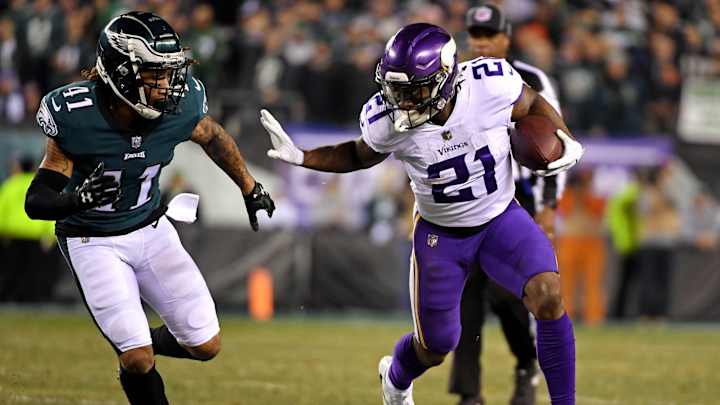Remembering what a Healthy Jerrick McKinnon Brings to the Table

On March 14th, 2018, the 49ers signed McKinnon to a four-year, $30 million deal. It included $18 million in guarantees, with $11.7 million of those guarantees due at signing.
Without a doubt McKinnon is arguably one of, if not the worst free agent signing throughout the John Lynch and Kyle Shanahan era. McKinnon has made more than $16 million with the team in two seasons, yet hasn’t played a regular season snap.
Despite the McKinnon signing going in the exact opposite direction of what Lynch and Shanahan expected, the 49ers’ brass clearly had a vision of what McKinnon could do in Shanahan’s offense.
After restructuring his contract earlier this offseason, McKinnon will have one more crack at justifying the thought process behind Lynch and Shanahan giving him such a lucrative deal. Let’s revisit what the thought process behind signing McKinnon could’ve been at the time.
McKinnon is an explosive athlete:
And when I say explosive, I mean explosive. During his 2014 combine, McKinnon put together one of the most impressive performances ever by a running back. These are McKinnon’s numbers in comparison to Saquon Barkley, who has been considered a “generational talent”.
McKinnon’s combine (‘14)
- Height/Weight: 5’9”/209
- Broad Jump: 11’0”
- Vertical Jump: 40.5”
- Bench Press: 32nd (tied-8th for the entire combine)
- 40-Yard Dash: 4.41
Barkley’s combine (‘18)
- Height/Weight: 6’0”/225
- Broad Jump: N/A
- Vertical Jump: 41”
- Bench Press: 29
- 40-Yard Dash: 4.4
The 49ers 2017 running back was Carlos Hyde, and the team opted not to re-sign Hyde during the 2018 offseason. Instead, they brought in McKinnon. He and former Atlanta Falcons running back Davonta Freeman have similar builds, and I believe Shanahan’s vision was of McKinnon being in San Francisco’s offense what Freeman was in his Atlanta offense.
McKinnon as a three-down back
With the Vikings, McKinnon never was the featured back. However, he showed he was more than capable of developing into one despite his limited role.
Throughout his four seasons with the Vikings, McKinnon averaged the following numbers per season:
- Rush Attempts: 118.5
- Rushing Yards / Per Attempt: 479.5 / 4.05
- Receptions: 28
- Receiving Yards/ Per Reception: 236.25 / 8.4
- Yards-from-Scrimmage: 715.75
- Total Touchdowns: 3
Although the receiving numbers seem low, McKinnon really developed as a pass catcher towards the end of his Vikings tenure. During his final two seasons, McKinnon averaged 47 receptions for 477 yards and 2 touchdowns catching the ball out the backfield.
Furthermore, over his last two seasons, McKinnon averaged over 875 yards from scrimmage. McKinnon achieved these numbers despite serving as a spell back with the Vikings. He was either the No. 2 behind guys like Adrian Peterson and Latavius Murray, or he split time with Matt Asiata in their absence.
McKinnon was coming off his best season in the NFL when the 49ers signed him. At the time, he was clearly an ascending NFL talent. In 2017 (including playoffs), McKinnon had 644 rushing yards, 513 receiving yards, and scored 6 touchdowns.
In a larger role and, if able to maintain health, McKinnon could’ve very easily found himself in a position to put up vintage Devonta Freeman numbers.
McKinnon as a pass catcher
Even if McKinnon could not develop into a three-down back, he clearly would’ve been the top pass catcher out of the backfield.
In 2017, the 49ers targeted Carlos Hyde out of the backfield 88 times. In Hyde’s five other NFL seasons combined, he has been targeted a total of 96 times.
Having running backs that can catch the ball out of the backfield is something Shanahan cherishes, and McKinnon’s pass-catching ability is superior to any other 49ers running back in recent memory
McKinnon was a proven durable player
At the time of the signing, there was no reason to believe McKinnon would struggle to stay healthy.
There are zero reports of McKinnon getting hurt during his time at Georgia Southern, and throughout his entire Vikings career he only missed one game to injury (ankle).
Up until he suffered the grade 3 ACL tear on September 1st, 2018, McKinnon was a healthy running back.
What to expect from a healthy McKinnon in 2020
Without question, the hope of McKinnon developing into a vintage Devonta Freeman is long gone. However, there is still hope for a healthy McKinnon to be productive in a similar role that he held with the Vikings.
McKinnon caught 65 passes in 18 games when he was healthy in 2017. In 19 games last season, Tevin Coleman, Matt Breida, Raheem Mostert, and Jeff Wilson Jr. combined for 62 receptions. McKinnon clearly brings above average value as a pass catcher that the 49ers do not have in their other running backs.
McKinnon serving as the third-down and rotational back where he sees 8-10 touches per game seems like a realistic possibility, as long as he stays healthy. Over a full season of games, that would put McKinnon anywhere from 128-160 touches. That would be around the volume of the 154 touches he averaged per season with the Vikings.
Jerrick McKinnon is one of the top storylines to follow as the 2020 season approaches. Will McKinnon ever get a chance to see a regular season snap in a 49ers uniform? Will he be able to even slightly justify the rationale behind the signing?
If healthy and fully recovered, McKinnon can help take the 49ers’ offense to the next level by adding an explosive pass catcher out of the backfield.
--Follow me on Twitter: @NinerNick_22
